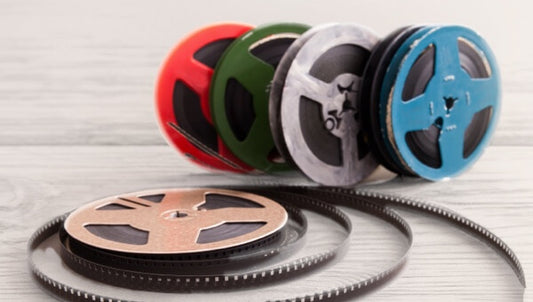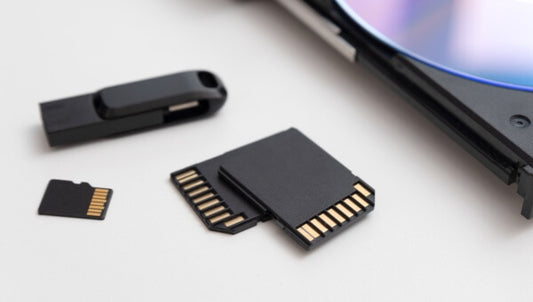In the late 1970s, there was a videotape format war and while VHS tapes ended up being the winner, Betamax remained a fairly popular home video format for around 20 years. But what is Betamax, how does it work, and what makes it different from other video cassette formats? Keep reading to learn about the rise of Betamax, the format war, certain features of Beta tapes, a landmark legal case involving Betamax, and interesting little-known facts about the Betamax legacy.
Jump to:
- What is Betamax?
- How Betamax Worked
- The Rise of Betamax
- The Format War: Betamax vs VHS
- Betamax Features and Limitations
- The Legal Battle and Sony Corp. v. Universal City Studios
- Legacy and Obsolescence
- Lesser-Known Facts About Betamax
- Frequently Asked Questions
- Preserving Betamax Memories for the Future
What is Betamax?
Betamax, also called Beta, is a type of consumer video cassette recorder (VCR) developed by Sony in Japan. This videotape format was released in 1975 and uses magnetic tapes to record home movies as well as TV programs.
Betamax, also called Beta, is a type of consumer video cassette recorder (VCR) developed by Sony in Japan. This videotape format was released in 1975 and uses magnetic tapes to record home movies as well as TV programs.

How Betamax Worked
Betamax was a magnetic videotape recording system that used half-inch (12.7 mm) tape coated with magnetic particles to store both sound and video.
When placed in a Betamax VCR, the tape:
- Moved between two spools inside the cassette
- Wrapped around a spinning drum that recorded and played back images
- Stored video and audio as magnetic signals on separate tracks
This process, called helical scan recording, allowed the tape to hold more information in a smaller space. Betamax recorders also featured timers and TV tuners, making it easy for users to record shows directly at home.
The Rise of Betamax
Sony’s Betamax format was introduced as a solution to the problem of storing lots of video information without requiring expensive equipment. Prior to Betamax, Sony had released the U-Matic tape that never seemed to catch on. It was simply too bulky and impractical, but they continued to work on that technology, which led to Beta.
The Betamax magnetic tape they released could store around an hour of audio/visual footage and while JVC’s VHS format was released the next year in 1976, many believed Betamax tapes to be the superior format.
According to Sony, the name “Beta” carried a double meaning. In Japanese, it referred to the way the technology functioned, while the Greek letter beta (β) represented the tape reels. The word “Max” was added to suggest maximum performance and appeal.
Betamax videotapes are very compact and smaller than VCR VHS while simultaneously offering higher image and sound quality. Betamax offered higher horizontal resolution than alternatives and sound fidelity. Plus, even though they could initially only hold about an hour of footage, later NTSC and PAL Beta Hi-Fi formats could record up to 5 hours.
Still, it was obvious they had a competition with JVC that kicked off the famed format war between VHS and Betamax tapes.

Though now obsolete, Betamax remains an important part of video history.
The Format War: Betamax vs. VHS
VHS, short for Video Home System, eventually became the standard for home video, but it first had to win a long battle against Betamax.
When comparing the two formats, Betamax offered better picture quality and sound, yet other factors shaped the final outcome. Sony controlled the Betamax format tightly, charging other companies to use its technology. This made Betamax products more expensive and less accessible.
JVC took the opposite approach. It shared its VHS technology freely, allowing other manufacturers like RCA and Matsushita to produce their own VHS tapes and players. This made VHS more affordable and easier to find.
By the early 1980s, cost became a major factor for consumers. A VHS VCR cost around $200, while a Betamax player could cost up to $1,500 or more. The lower price and wider availability helped VHS quickly dominate the market.
Rental stores also favored VHS because of its longer recording time, lower price, and higher demand. Even though Betamax players were made until 2002 and tapes until 2016, only about 18 million Betamax devices were ever sold. By comparison, more than 32 million VHS copies of The Lion King alone were sold.
So, why did VHS win the format war? The answer is simple: it was cheaper, more available, and offered longer recording times. Its compact offshoot, VHS-C, also made recording and playback easier, giving VHS the clear advantage for everyday home use.
Betamax Features and Limitations
Betamax delivered impressive picture quality for its time. With a resolution of 333 x 486, compared to VHS’s 320 x 486, it offered a slightly sharper and clearer image. Many users also liked its richer colors, strong sound quality, and smaller, compact design.
Sony continued improving the format for years. In 1988, they introduced ED-Beta (Extended Definition Betamax), capable of recording up to 500 lines of luma resolution. This was similar to DVD quality that wouldn’t be introduced until almost a decade later.
Still, Betamax had its drawbacks:
- Shorter recording time: The original Beta I tapes could record about one hour, while VHS offered around 2.5 hours. Later versions could reach five hours, but S-VHS long-play tapes could record nearly ten hours.
-
Limited playback options: Betacam camcorders could not display footage on their own. To watch a recording, users needed a separate Betamax player. VHS camcorders, on the other hand, let users view their videos directly on the camera screen.
Betamax offered great image quality and innovation, but shorter recording times and less convenience made VHS the preferred choice for most households.

The Legal Battle and Sony Corp. v. Universal City Studios
In 1984, the Betamax case reached the Supreme Court of the United States. The issue centered on whether consumers could legally record entire television shows using home video recorders.
The problem arose when Universal Studios sued Sony and its distributors because Sony was manufacturing Betamax which could be used for copyright infringement. That was the downside of being the first ever consumer recording format.
However, the Supreme Court ruled that making individual copies of television programs was considered fair use and not an infringement on copyright law. This ruling continued to influence decisions on copyright law and technology.
As file sharing using the internet ramped up in the 1990s and into the 2000s, the decision in the Sony Betamax case would be used in the Napster case as well as other future file-sharing rulings. In 1998, the Digital Millennium Copyright Act was implemented that criminalizes the production of technology, devices, or services that were intended to circumvent access to copyrighted works.
With the widespread share of technology and files online, the Betamax court case still affects your ability to access music, television shows, movies, and other content online today. That’s why you need an official subscription to a service that pays for the content to be able to view it legally.
It also prevents you from using a digital converter to copy and distribute copyrighted content, but you can still digitize your home movies as much as you want!
Legacy and Obsolescence
Betamax was the first practical video tape recorder and an important milestone in home video technology. It introduced compact camcorders, influenced copyright law, and encouraged families to record and preserve their memories.
As new technologies emerged, formats like HD DVDs, Blu-rays, and streaming platforms replaced analog video. Digital recording became the easier option because it allowed people to:
- Store more videos in less space
- Watch or delete recordings instantly
- Share files online within seconds
- Enjoy higher sound and picture quality
Betamax remained popular in broadcasting and video production for many years due to its image quality and reliability. Even after digital formats took over, professionals continued to use it until they fully transitioned to modern technology.
Although Betamax is now obsolete, it played a key role in shaping how people recorded, shared, and preserved their videos.

Lesser-Known Facts About Betamax
While we’ve already answered, “What is Betamax?”, “When did Betamax come out?” and many other essential questions about the cassette format, there are some lesser-known facts that you might find interesting.
Sony Didn’t Make VHS Tapes Until 1988
While many producers made VHS tapes throughout the 80s because JVC shared their technology, Sony continued to focus on Betamax. However, in 1988 Videofax Magazine declared Beta lost the format war and Sony finally agreed to start producing VHS tapes and VCRs.
The Adult Film Industry Influenced the Format War Outcome
Many people think that one of the main reasons that Betamax lost the format war was because of the pornography industry. You see, VHS tapes offered longer playback and accessibility. Not only that, but Sony decided they didn’t want adult films recorded in their format. By the end of the 1970s, erotic films made up a significant portion of videotape sales, and they chose VHS.

Betamax Was More Popular in Japan
While VHS dominated the format war in the United States, Betamax faired better in Japan. While Sony’s format still lost the format war, they continued to have decent sales in Japan for years. In fact, this is probably the reason they didn’t cease production of Betamax until 2016.
Frequently Asked Questions
What is Betamax used for today?
Betamax is mainly used by collectors and video enthusiasts who restore or digitize old tapes for preservation.
Can you still play Betamax tapes?
Yes, but you need a working Betamax player, which can be hard to find. Many people convert their tapes to digital for easier access.
When did Sony stop making Betamax?
Sony stopped producing Betamax players in 2002 and discontinued tape production in 2016.
How long do Betamax tapes last?
When stored in a cool, dry place, Betamax tapes can last 20 to 30 years, although playback quality tends to decline over time.
Why did Betamax fail?
Betamax offered great picture quality but lost to VHS because of higher prices, shorter recording times, and limited availability.
What is the difference between Betamax and Betacam?
Betamax was made for home use, while Betacam was a professional-grade version used in television and film production.
Are Betamax tapes worth anything today?
Most have low resale value, but rare or unopened titles, especially in good condition, may interest collectors.
Can Betamax tapes be converted to digital?
Yes. Betamax recordings can be transferred to digital formats to prevent further degradation and make them easier to store and share.
How does Betamax compare to VHS in quality?
Betamax had slightly sharper video and better sound, but VHS won due to longer recording times and lower cost.
What size were Betamax tapes?
Betamax cassettes measured about 6.1 x 3.75 inches, smaller and more compact than VHS tapes.

Preserving Betamax Memories for the Future
Betamax may not have been as popular as VHS tapes, but as the first consumer-friendly and practical home video cassette, it had a profound influence on the industry. Plus, Betamax tapes offer great quality sound and picture and an easy-to-use compact design. However, tapes won’t last forever, which is why it’s so important to convert Betamax to digital and preserve those memories forever.
Capture can convert your memories to high-quality digital format so you can view, share, and preserve them for future generations to enjoy.











